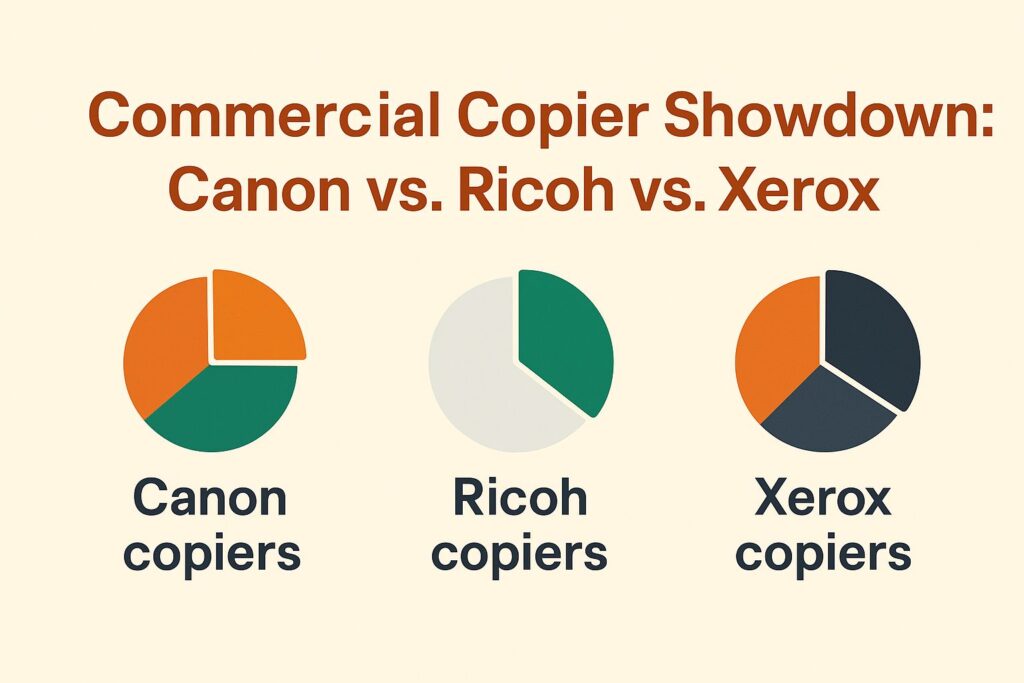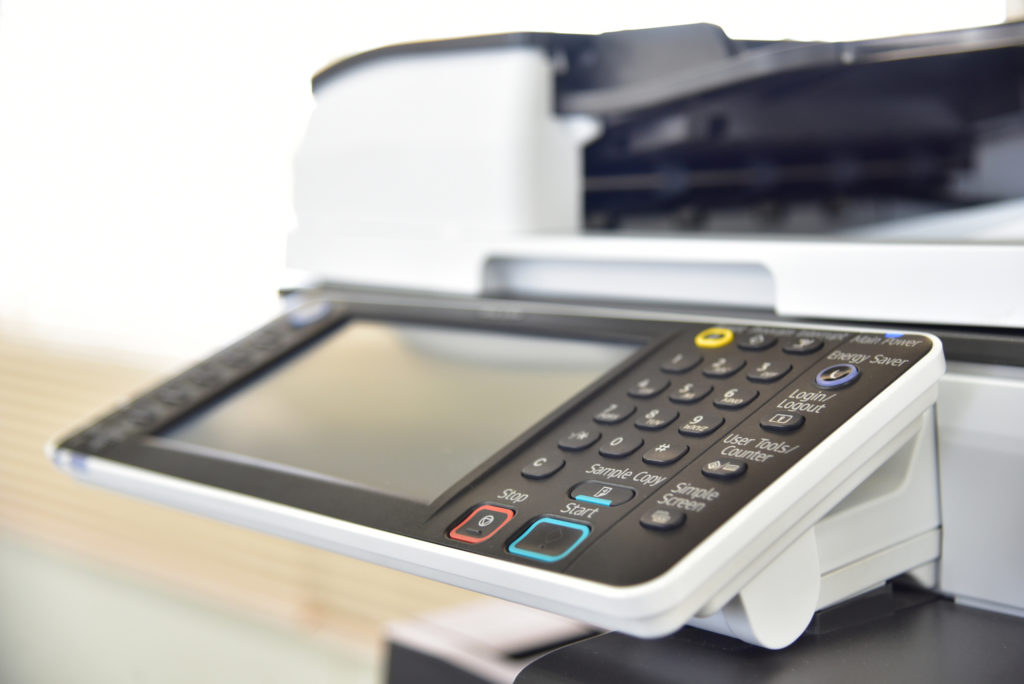
Commercial Copier Showdown: Canon vs. Ricoh vs. Xerox
Regarding commercial copiers, choosing the right brand with reliable copier technology can make all the difference for your business. This article compares three industry heavyweights: Canon, Ricoh, and Xerox.
Key factors such as volume and speed, essential copier functionality, features and functions, as well as cost and maintenance considerations will be explored. We will examine brand reputation and customer support to help you make a well-informed decision.
This breakdown highlights the strengths and weaknesses of each brand in this detailed feature comparison.
Comparison of Canon, Ricoh, and Xerox Commercial Copier Market Share
Choosing the right commercial copier for your business means comparing Canon, Ricoh, and Xerox carefully, as each has different pros and cons, including printing technology and color printing capabilities.
Canon is known for great print quality, advanced printing technology, and exceptional ink efficiency. Ricoh is appreciated for being cost-effective, offering durability, and having durable multifunction printers with faxing capabilities. Xerox is known for its strong brand reputation, reliability, customer support, and advanced features including security features.
This decision is important for improving office productivity and meeting your business needs, ensuring a good return on investment (ROI).
Commercial Copier Market Share

The Commercial Copier Market Share 2024 data gives a detailed examination of the market’s expected growth, size, and volume patterns over the next few years, highlighting important advertising methods. This data is important for learning about the direction of the industry and finding possible opportunities and problems.
Market Value and Growth metrics indicate a Compound Annual Growth Rate (CAGR) of 4.6% from 2024 to 2034, suggesting steady long-term growth driven by technological advancements and increasing demand for efficient office equipment. However, the time from 2025 to 2029 has a much smaller CAGR of 0.87%, indicating a potential slowdown during these years. This might be due to market saturation or economic fluctuations affecting purchasing power.
- The market value is projected to grow from $727.2 million in 2023 to $1.2 billion by 2034. This increase shows the importance of clever investments in fresh concepts and addressing customer needs to capture more of the market.
- In 2025, the market revenue is expected to reach an impressive $9.8 billion, with China’s contribution being significant at $2.3 billion. This shows China’s key role in increasing market demand, likely because its business areas are growing and it is embracing technology.
Market Volume growth portrays a modest 1.2% increase in 2026, with the total volume reaching 108.2 million units by 2029. The increase in volume shows continuous demand and indicates that the market will grow gradually. Manufacturers should pay attention to making their products stand out and tailoring them to meet specific needs.
The data on Commercial Copier Market Share for 2024 shows ongoing market growth, driven by technology changes and regional market shifts, especially in China. Businesses should apply this information to improve their plans, concentrating on new ideas and specific market demands to increase their ability to compete and seize new opportunities.
1. Volume, Speed, and PPM
Knowing the volume, speed, and PPM of commercial copiers is important for businesses that depend on printing technology, as these factors directly affect efficiency and productivity.
Companies can gain clear benefits by choosing a printer model that matches their specific requirements in the current market. For instance, Canon models are known for their impressive print speeds, often reaching upwards of 70 pages per minute, while maintaining high-quality output.
However, Ricoh machines often manage high volumes of printing, making them suitable for busy environments, provided they receive regular maintenance to control costs.
Xerox, known for its reliability, combines solid durability with efficient maintenance practices, ensuring long-term value. By looking at technical details and user feedback, businesses can make well-informed decisions to improve their printing abilities and reduce interruptions.
2. **Features, Functions, and Product Improvements**
The features and functions of commercial copiers can significantly impact a business’s workflow, so it’s important to assess the multiple capabilities of Canon, Ricoh, and Xerox models.
These brands each offer a unique set of strengths that can cater to different business needs.
For instance, scanning capabilities often vary, with some models providing high-resolution scans that are ideal for document archiving.
Faxing features can vary, with some devices providing faster speeds and dependable performance, important for urgent communications.
Connectivity options, such as wireless and mobile printing, play a key role in ensuring that employees can easily access print services from various devices.
Choosing suitable colors is key to making marketing materials. Correctly handling paper and updating software are essential for efficiently dealing with various media.
Using software effectively can make tasks simpler and improve how well things function. Worth exploring: Important Features to Look For in Office Copiers.
3. Cost, Maintenance, and TCO/ROI
Knowing the cost, TCO, and upkeep of commercial copiers helps businesses save money and plan for upcoming expenses while enhancing ROI.
There are a variety of pricing models available, including outright purchases, leasing agreements, and pay-per-click options, which can significantly impact a company’s budget.
When looking at brands like Canon, Ricoh, and Xerox, it is important to review the leasing options they offer, as these can provide different choices based on the company’s printing requirements and budget.
Maintenance costs vary by brand and model and often depend on the included service contracts, which can cover service calls and repairs.
Beyond initial costs, consumables such as toner and paper should also be factored into the overall economic sustainability, as these recurring expenses may influence the long-term viability of a particular copier choice for any organization.
4. Brand Reputation and Customer Support
Brand reputation and customer support are critical factors when choosing a commercial copier, as they can greatly affect your business’s experience and satisfaction with the product.
Choosing the right copier brand can mean the difference between seamless operations and frustrating downtimes. For many businesses, the experiences shared by peers often influence this decision.
Canon, Ricoh, and Xerox are known for their unique reputations, formed by how they support their customers and their warranty options. User reviews often mention Canon’s friendly service team, noting their ability to solve problems and respond quickly.
Unlike others, Ricoh’s warranty choices are known for covering all aspects, which reassures many clients. Meanwhile, testimonials for Xerox often commend their flexible service agreements, which accommodate scaling business needs effectively and are well-received by users.
These aspects of customer service, market positioning, and satisfaction are important in developing a company’s lasting relationship with its equipment supplier.
About the Author
Ethan Cole is a business growth advisor and serial entrepreneur with over two decades of hands-on experience helping startups and small businesses thrive. With a background in finance and operations, he’s led multiple companies from early-stage concepts to multi-million-dollar exits. Ethan specializes in scaling strategies, cost reduction, and building systems that support sustainable growth. As a content contributor for Kwote Advisor, he shares practical insights to help business owners make smarter decisions when launching, managing, and expanding their ventures.



